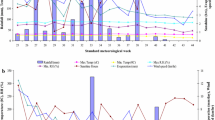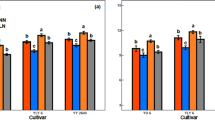Abstract
System of rice intensification (SRI) has been disseminated in many countries because of its high yield, although the mechanism of yield increase has yet to be fully understood. The aims of this study were to clarify the actual water management of a skilled SRI farmer in irrigated paddy field of Indonesia and to examine the effect of intermittent water management on rice growth and yield. Yield and yield components were compared in the field experiments in the farmer’s fields under intermittent (SRI) or flooded (FL) irrigation for 4 years from 2013 to 2016. The daily mean water depth of SRI plots during 0–40 days after transplanting showed very shallow (ca. 2 cm) or little lower than soil surface and continued to be lower than soil surface during reproductive stage when panicles were formed. The yield of SRI significantly exceeded that of FL for 4 years by 13% (P = 0.0004), so did the panicle numbers per area (P = 0.036). The yield increase in SRI was associated with the increased number of panicles, which should have resulted from enhanced tiller development under shallow water level during the vegetative stage. The increased number of panicles was, however, counteracted by the reduced number of spikelets per panicle and resulted in nonsignificant increase in the spikelet density, defined as number of spikelets per unit area of crop. This dampening change in spikelet number per panicle could have been caused by limited supply of either nitrogen or carbohydrate during the panicle development stage under the intermittent water supply. A greater yield increase by SRI could be expected by improving nutrient or water management during the reproductive stage.








Similar content being viewed by others
References
Amien I, Rejekiningrum P, Pramudia A, Susanti E (1996) Effects of inter annual climate variability and climate change on rice yield in Java, Indonesia. In: Erda L et al (eds) Climate change vulnerability and adaptation in Asia and the Pacific. Springer, Dordrecht
Barker R, Dawe D, Tuong TP, Bhuiyan SI, Guerra LC (2000) The outlook for water resources in the year 2020: challenges for research on water management in rice production. Int Rice Comm Newsl 49:7–21
Belder P, Spiertz JHJ, Bouman BAM, Lu G, Tuong TP (2005) Nitrogen economy and water productivity of lowland rice under water saving irrigation. Field Crops Res 93:169–185
Bouman BAM, Tuong TP (2001) Field water management to save water and increase its productivity in irrigated lowland rice. Agric Water Manag 49:11–30
Chapagain T, Yamaji E (2010) The effects of irrigation method, age of seedling and spacing on crop performance, productivity and water-wise rice production in Japan. Paddy Water Environ 8:81–90
Hasegawa T, Koroda Y, Seligman NG, Horie T (1994) Response of spikelet number to plant nitrogen concentration and dry weight in paddy rice. Agron J 86:673–676
Horie T, Ohnishi M, Angus JF, Lewin LG, Tukaguchi T, Matano T (1997) Physiological characteristics of high-yielding rice inferred from cross-location experiments. Field Crops Res 52:55–67
Irawan B (2002) Stabilization of upland agriculture under El Nino-induced climatic risk: impact assessment and mitigation measure in Indonesia, economics and social commission for Asia and the Pacific. CGPRT Center Working Paper, 62, 1–51
Kassam A, Stoop W, Uphoff N (2011) Review of SRI modifications in rice crop and water management and research issues for making further improvements in agricultural and water productivity. Paddy Water Environ 9:163–180
Lee YH, Kobayashi K (2017) Rice yield increase by the system of rice intensification is dependent on supplementary water availability in rainfed lowland fields of southern Cambodia. Trop Agric Dev 61:48–55
Lee YH, Kobayashi K (2018) Assessing the acceptance of the system of rice intensification among farmers in rainfed lowland rice region of Cambodia. Paddy Water Environ. https://doi.org/10.1007/s10333-018-0646-y
Lin XQ, Zhu DF, Lin XJ (2011) Effects of water management and organic fertilization with SRI crop practices on hybrid rice performance and rhizosphere dynamics. Paddy Water Environ 9:33–39. https://doi.org/10.1007/s10333-010-0238-y
Menete MZL, van Es HM, Brito RML, DeGloria SD, Famba S (2008) Evaluation of system of rice intensification (SRI) component practices and their synergies on salt-affected soils. Field Crops Res 109:34–44
Mishra A, Salokhe VM (2011) Rice root growth and physiological responses to SRI water management and implications for crop productivity. Paddy Water Environ 9:41–52
Murayama N (1969) Nitrogen nutrition of rice plant. JARQ 3:1–4
Nugroho BDA (2016) Fenomena iklim Global, perubahan iklim dan dampaknya di Indonesia. Universitas Gadjah Mada Press, Yogyakarta, pp 60–70 (In Indonesian)
Sato S, Yamaji E, Kuroda T (2011) Strategies and engineering adaptions to disseminate SRI methods in large-scale irrigation systems in Eastern Indonesia. Paddy Water Environ 9:79–88. https://doi.org/10.1007/s10333-010-0242-2
Uphoff N, Kassam A, Harwood R (2011) SRI as a methodology for raising crop and water productivity: productive adaptations in rice agronomy an irrigation water management. Paddy Water Environ 9:3–11
Won JG, Choi JS, Lee SP, Son SH, Chung SO (2005) Water saving by shallow intermittent irrigation and growth of rice. Plant Prod Sci 8:487–492
Yang C, Yang L, Yang Y, Quyang Z (2004) Rice root growth and nutrient uptakes as influenced by organic manure in continuously and alternately flooded paddy soils. Agric Water Manag 70:67–81
Yokoyama S (2003) ENSO impacts on food crop production in Indonesia. Indones Q 31:88–96
Zhao LM, Wu LH, Wu MY, Li YS (2011) Nutrient uptake and water use efficiency as affected by modified rice cultivation methods with reduced irrigation. Paddy Water Environ 9:25–32. https://doi.org/10.1007/s10333-011-0257-3
Acknowledgements
The authors gratefully acknowledge the sincere and continued cooperation of the skilled farmer Mr. Suparno of Gemawang village for this study. We also thank Dr. Benito, Prof Sigit Supadmo, Rizki Maftukhah, Fadila, Umi Hapsari, lecturers and students of Gadjah Mada University for their kind cooperation to continue this research.
Funding
Funding was provided by The Directorate of Higher Education,Ministry of Natinal Education,Republic of Indonesia (Grant No. 2271/UN1.P.III/DIT-LIT/LT/2017), and Japan Society for the Promotion of Science (Grant No. 23255014).
Author information
Authors and Affiliations
Corresponding author
Rights and permissions
About this article
Cite this article
Nugroho, B.D.A., Toriyama, K., Kobayashi, K. et al. Effect of intermittent irrigation following the system of rice intensification (SRI) on rice yield in a farmer’s paddy fields in Indonesia. Paddy Water Environ 16, 715–723 (2018). https://doi.org/10.1007/s10333-018-0663-x
Received:
Revised:
Accepted:
Published:
Issue Date:
DOI: https://doi.org/10.1007/s10333-018-0663-x




